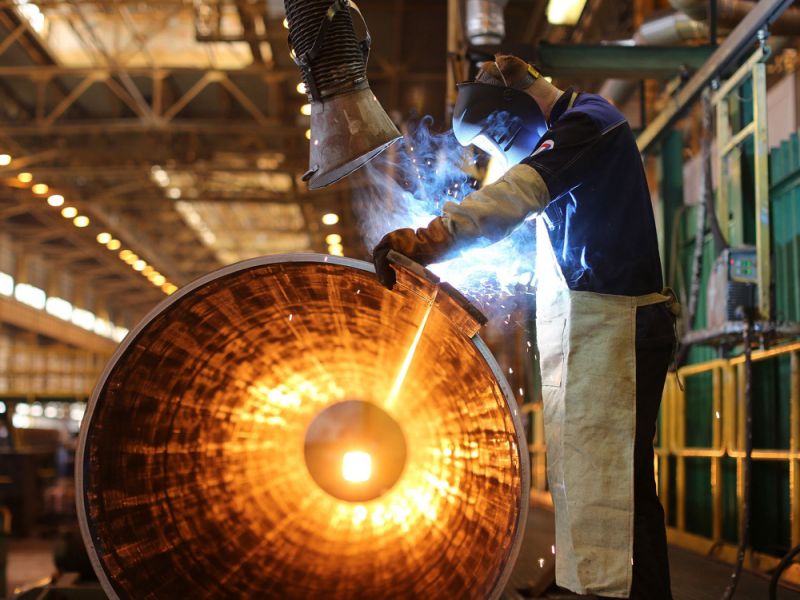

(Bloomberg) — The latest snapshot of U.S. employment underscored mounting risks to the economy as President Donald Trump boosts tariffs on Chinese goods, threatening already-suffering factories and stores.
While overall payroll gains were healthy in July, retail employment dropped for a sixth straight month to a three-year low, Labor Department figures showed Friday, amid fierce competition from Amazon.com Inc. and other online sellers. At factories — already in a technical recession thanks to global weakness and the trade war — — average weekly hours worked sank to the lowest since 2011.
Both industries are poised for further pain. Trump’s levies and China’s retaliatory actions have hit goods producers hardest, with businesses paying higher costs, delaying expansion and hiring fewer people. The latest tariffs would expand that impact to consumers, who are driving the expansion, with a 10% tax on an additional $300 billion in goods including electronics and clothing.
U.S. stocks tumbled Friday, heading toward the worst week of 2019, as investors fretted over trade war escalation. Treasuries rose.
“Employment growth is still pretty solid, although there has been some slowing,” said Jim O’Sullivan, chief U.S. economist at High Frequency Economics. “The accumulation of the trade actions is only acting as a drag on the economy.”
Beyond the details, the report broadly showed employment in good-enough shape to sustain the economic expansion and the Federal Reserve’s statement this week that that the labor market “remains strong.”
Payrolls rose 164,000, though the two prior months were revised lower. The jobless rate held at 3.7%, near a half-century low, while average hourly earnings climbed 3.2% from a year earlier, better than forecast.
What Bloomberg’s Economists Say
“The consensus forecast was off by just 1,000 on July payrolls, but the net takeaway was considerably weaker in light of downward revisions and a pullback in the workweek … The jobs data suggest that labor momentum is already cooling, and further damping ‘animal spirits’ will only serve to exacerbate the trend.”– Carl Riccadonna, Yelena Shulyatyeva and Eliza WingerClick here to read the full note.
Despite July’s healthy payrolls figure, the three-month average increase of 140,000 was the slowest in almost two years. That trend is in line with forecasts for a gradual slowing of job gains as the labor market tightens, but it could also be seen as a sign that the economy is losing steam.
While factories added 16,000 employees, the most since January, the overall picture is less encouraging: Goods producers including construction and mining companies added 15,000 jobs, less than half the five-year average.
“You’re continuing to see that year-over-year slowdown in the goods industries and that reflects the problems caused by the trade war,” said Martha Gimbel, research director at jobs website Indeed’s Hiring Lab and former economist at the Labor Department and Council of Economic Advisers. “Given the announcement yesterday about China it’ll be interesting to see if job growth in those industries levels off at some point or continues to decline.”
At retailers, the decline in workers brought total employment to the lowest level since early 2016. Employees in warehousing and storage, sometimes seen as a proxy for online sellers, rose to a record 1.19 million.
Fed Chairman Jerome Powell pointed to the trade fight as one of the major factors risking the U.S. economy’s health in a press conference this week, after policy makers cut interest rates by 25 basis points. Powell said that while U.S. indicators show the economy remains in good shape, the central bank signaled it was watching trade developments closely.
Investors boosted bets on additional Fed easing following Trump’s tariff threat. Economic adviser Larry Kudlow said Friday that “any impact on U.S. consumers is minuscule” from the levies. “The economic burden of these tariffs has fallen most heavily on China,” he told Bloomberg Television.
Other points in the jobs report were positive. The pickup in wages indicates employers face a tough time finding workers and also bodes well for resilient consumer spending amid tariffs.
And the U-6, or underemployment rate, fell to 7%, the lowest since 2000, from 7.2%. That includes part-time workers who’d prefer a full-time position and people who want a job but aren’t looking.
Payroll growth is “still in excess of what we need to see to keep up with population growth,” said Michelle Meyer, head of U.S. economics at Bank of America Corp. “It still suggests that the economy is growing above trend, but there’s been some moderation.”
–With assistance from Chris Middleton, Benjamin Purvis, Sophie Caronello and Ryan Haar.
To contact the reporters on this story: Katia Dmitrieva in Washington at [email protected];Reade Pickert in Washington at [email protected]
To contact the editors responsible for this story: Scott Lanman at [email protected], Vince Golle, Jeff Kearns
<p class="canvas-atom canvas-text Mb(1.0em) Mb(0)–sm Mt(0.8em)–sm" type="text" content="For more articles like this, please visit us at bloomberg.com” data-reactid=”47″>For more articles like this, please visit us at bloomberg.com
©2019 Bloomberg L.P.






